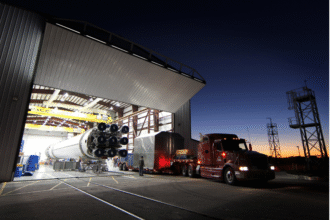For most of the space age, launching payloads into space was incredibly expensive, limited to governments, massive corporations, and scientific institutions with deep pockets. Then came SpaceX, a private company that changed the game by revolutionizing how we think about space launch economics. From reusable rockets to affordable ride-sharing missions, SpaceX created a cost revolution that continues to ripple across the aerospace industry.
Let’s explore how SpaceX reduced launch costs, disrupted the traditional business model, and made space more accessible than ever before.
The Old Model: High Costs and No Room for Innovation
Before SpaceX entered the picture, space missions were typically conducted using rockets designed for one-time use. After launching, these expensive boosters would burn up in the atmosphere or crash into the ocean, making each mission cost-prohibitive.

Major Challenges in Traditional Space Launches:
Expendable Rockets: Hardware worth millions was discarded after every launch.
Long Development Cycles: Rockets took years to design, test, and build.
Limited Competition: A few aerospace giants dominated the market, leading to inflated costs.
Government Dependency: Most space missions were publicly funded and lacked cost incentives.
For example, a single Space Shuttle mission could cost nearly $450 million, and other expendable rockets weren’t much cheaper. The space launch cost comparison looked grim for smaller companies and countries with limited budgets.
The SpaceX Disruption Begins

Founded by Elon Musk in 2002, SpaceX aimed to reduce the cost of space travel dramatically. The company’s vision extended beyond Earth orbit—it sought to make Mars colonization feasible. But the first milestone was to cut launch costs and improve access.
Innovations That Reshaped Launch Economics
1. Reusable Rockets
SpaceX’s biggest contribution to reducing launch costs is the development of reusable rockets. Traditional rockets were single-use, but SpaceX engineered boosters that could land vertically and be flown again.
How It Works:
- Falcon 9’s first stage returns to Earth and lands upright.
- These boosters can be reused up to 15 times.
- Each reuse saves millions of dollars on hardware and material costs.
This significantly lowered the per-launch cost, with estimates showing missions dropping from over $100 million to around $50–60 million or less. The success of this model proved that reusability is essential for sustainable and affordable spaceflight.
2. Vertical Integration

Unlike traditional aerospace companies that outsource many components, SpaceX builds most of its parts in-house. This vertical integration allows for:
- Faster iteration and innovation
- Lower production costs
- Tighter quality control
It also ensures a more streamlined SpaceX pricing guide that offers transparency and consistency for clients.
3. High Launch Frequency
SpaceX launches rockets frequently—sometimes multiple missions per week. This high cadence spreads fixed costs across more missions and improves economies of scale.
4. Affordable Ride-Share Programs
SpaceX introduced a new model of shared launches, where multiple clients can send their payloads on a single rocket. This significantly reduces satellite deployment costs for startups, universities, and small space agencies.
Clients can now book a satellite launch with SpaceX online, choosing available missions and payload capacities much like booking a flight ticket.
Falcon 9: The Star of the Cost Revolution
Falcon 9 is one of the most successful rockets in history and a cornerstone of SpaceX’s business model.
Features:
- Launch cost: Around $67 million (significantly lower than competitors)
- Payload capacity: Up to 22,800 kg to Low Earth Orbit (LEO)
- Reusability: Proven track record of booster recovery and reuse
- Global launches: From sites in Florida, California, and beyond
Many clients rely on Falcon 9 for deploying satellites, space station cargo, and even astronauts. For those seeking details, the Falcon 9 specs are widely available and demonstrate why it's the top choice for low-cost missions.
Starship: The Future of Affordable Space Access
SpaceX is developing Starship, a fully reusable, next-generation launch system designed to go beyond Earth orbit.
Why Starship Matters:
- Full reusability: Both the booster (Super Heavy) and upper stage are designed to be reused.
- High payload capacity: Over 100,000 kg to orbit.
- Lower cost per kilogram: Expected to fall below $200/kg, a massive drop in traditional launch costs.
Starship could make missions to the Moon, Mars, and even interplanetary cargo deliveries economically viable. It is poised to be a game-changer for global space ambitions.
Global Impact on the Space Industry
SpaceX's launch economics are not only beneficial to the company but also disruptive to the entire industry. Here’s how:
Lower Barriers for Entry
To lower costs, more organizations can now enter space:
- Startups building Earth observation or communication satellites
- Universities conducting space research with CubeSats
- Developing countries are launching their first satellites
New Competitors and Collaborations
Companies like Rocket Lab, Blue Origin, and Relativity Space have accelerated their reusable rocket programs in response. This means better pricing and more options for customers.
Increased Innovation
With more players in the market and more launches happening, innovation is moving faster:
- Advanced propulsion systems
- In-orbit services
- Autonomous satellite technologies
SpaceX’s cost-focused model directly influences these commercial space industry trends.
Navigating the New Launch Economy
For anyone entering the space economy—whether a scientist, entrepreneur, or government agency- understanding how SpaceX changed the rules is vital.
Tips:
- Monitor the SpaceX launch schedule to identify available rideshare slots.
- Use the SpaceX pricing guide to compare options based on payload size and destination.
- Analyze space launch cost comparisons to make informed financial decisions.
- Leverage Falcon 9 specs and technical data for compatibility checks.
- Stay informed on commercial space industry trends and emerging technologies.
Conclusion:
SpaceX has done what many thought was impossible. Through innovation, reusability, and an entrepreneurial approach, it transformed the economics of space launch. What once cost hundreds of millions of dollars is now accessible for a fraction of the price.
This cost revolution has made space more democratic, accelerated innovation, and expanded global participation. With Starship on the horizon, SpaceX is not slowing down. The dream of affordable space access—for satellites, research, and eventually people—is becoming reality.
Thanks to SpaceX, space is no longer the exclusive realm of the elite. It’s now open for business.







